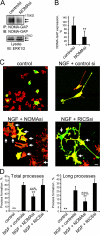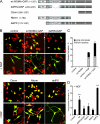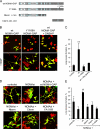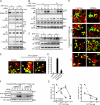The neurite outgrowth multiadaptor RhoGAP, NOMA-GAP, regulates neurite extension through SHP2 and Cdc42
- PMID: 17664338
- PMCID: PMC2064841
- DOI: 10.1083/jcb.200609146
The neurite outgrowth multiadaptor RhoGAP, NOMA-GAP, regulates neurite extension through SHP2 and Cdc42
Abstract
Neuronal differentiation involves the formation and extension of neuronal processes. We have identified a novel regulator of neurite formation and extension, the neurite outgrowth multiadaptor, NOMA-GAP, which belongs to a new family of multiadaptor proteins with RhoGAP activity. We show that NOMA-GAP is essential for NGF-stimulated neuronal differentiation and for the regulation of the ERK5 MAP kinase and the Cdc42 signaling pathways downstream of NGF. NOMA-GAP binds directly to the NGF receptor, TrkA, and becomes tyrosine phosphorylated upon receptor activation, thus enabling recruitment and activation of the tyrosine phosphatase SHP2. Recruitment of SHP2 is required for the stimulation of neuronal process extension and for sustained activation of ERK5 downstream of NOMA-GAP. In addition, we show that NOMA-GAP promotes neurite outgrowth by tempering activation of the Cdc42/PAK signaling pathway in response to NGF. NOMA-GAP, through its dual function as a multiadaptor and RhoGAP protein, thus plays an essential role downstream of NGF in promoting neurite outgrowth and extension.
Figures









Similar articles
-
Dok-4 regulates GDNF-dependent neurite outgrowth through downstream activation of Rap1 and mitogen-activated protein kinase.J Cell Sci. 2006 Aug 1;119(Pt 15):3067-77. doi: 10.1242/jcs.03043. Epub 2006 Jul 4. J Cell Sci. 2006. PMID: 16820412
-
A food-derived synergist of NGF signaling: identification of protein tyrosine phosphatase 1B as a key regulator of NGF receptor-initiated signal transduction.J Neurochem. 2008 Dec;107(5):1248-60. doi: 10.1111/j.1471-4159.2008.05686.x. Epub 2008 Oct 24. J Neurochem. 2008. PMID: 18796006
-
Small GTPase Rin induces neurite outgrowth through Rac/Cdc42 and calmodulin in PC12 cells.J Cell Biol. 2003 Dec 8;163(5):1067-76. doi: 10.1083/jcb.200308070. J Cell Biol. 2003. PMID: 14662747 Free PMC article.
-
The molecular functions of Shp2 in the Ras/Mitogen-activated protein kinase (ERK1/2) pathway.Cell Signal. 2008 Mar;20(3):453-9. doi: 10.1016/j.cellsig.2007.10.002. Epub 2007 Oct 11. Cell Signal. 2008. PMID: 17993263 Review.
-
Role of the Go/i signaling network in the regulation of neurite outgrowth.Can J Physiol Pharmacol. 2006 Jul;84(7):687-94. doi: 10.1139/y06-025. Can J Physiol Pharmacol. 2006. PMID: 16998532 Review.
Cited by
-
Neocortical dendritic complexity is controlled during development by NOMA-GAP-dependent inhibition of Cdc42 and activation of cofilin.Genes Dev. 2012 Aug 1;26(15):1743-57. doi: 10.1101/gad.191593.112. Epub 2012 Jul 18. Genes Dev. 2012. PMID: 22810622 Free PMC article.
-
SHP-2 deletion in postmigratory neural crest cells results in impaired cardiac sympathetic innervation.Proc Natl Acad Sci U S A. 2014 Apr 8;111(14):E1374-82. doi: 10.1073/pnas.1319208111. Epub 2014 Mar 24. Proc Natl Acad Sci U S A. 2014. PMID: 24706815 Free PMC article.
-
Cdo promotes neuronal differentiation via activation of the p38 mitogen-activated protein kinase pathway.FASEB J. 2009 Jul;23(7):2088-99. doi: 10.1096/fj.08-119255. Epub 2009 Feb 25. FASEB J. 2009. PMID: 19244314 Free PMC article.
-
SNX26, a GTPase-activating protein for Cdc42, interacts with PSD-95 protein and is involved in activity-dependent dendritic spine formation in mature neurons.J Biol Chem. 2013 Oct 11;288(41):29453-66. doi: 10.1074/jbc.M113.468801. Epub 2013 Sep 3. J Biol Chem. 2013. PMID: 24003235 Free PMC article.
-
Neuronal Cytoskeleton in Intellectual Disability: From Systems Biology and Modeling to Therapeutic Opportunities.Int J Mol Sci. 2021 Jun 7;22(11):6167. doi: 10.3390/ijms22116167. Int J Mol Sci. 2021. PMID: 34200511 Free PMC article. Review.
References
-
- Allen, M.J., X. Shan, and R.K. Murphey. 2000. A role for Drosophila Drac1 in neurite outgrowth and synaptogenesis in the giant fiber system. Mol. Cell. Neurosci. 16:754–765. - PubMed
-
- Aoki, K., T. Nakamura, and M. Matsuda. 2004. Spatio-temporal regulation of Rac1 and Cdc42 activity during nerve growth factor-induced neurite outgrowth in PC12 cells. J. Biol. Chem. 279:713–719. - PubMed
-
- Arevalo, J.C., D.B. Pereira, H. Yano, K.K. Teng, and M.V. Chao. 2006. Identification of a switch in neurotrophin signaling by selective tyrosine phosphorylation. J. Biol. Chem. 281:1001–1007. - PubMed
-
- Bentires-Alj, M., J.G. Paez, F.S. David, H. Keilhack, B. Halmos, K. Naoki, J.M. Maris, A. Richardson, A. Bardelli, D.J. Sugarbaker, et al. 2004. Activating mutations of the Noonan syndrome-associated SHP2/PTPN11 gene in human solid tumors and adult acute myelogenous leukemia. Cancer Res. 64:8816–8820. - PubMed
Publication types
MeSH terms
Substances
LinkOut - more resources
Full Text Sources
Other Literature Sources
Molecular Biology Databases
Miscellaneous

